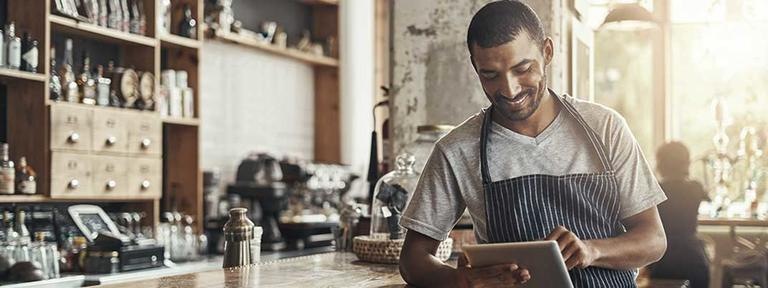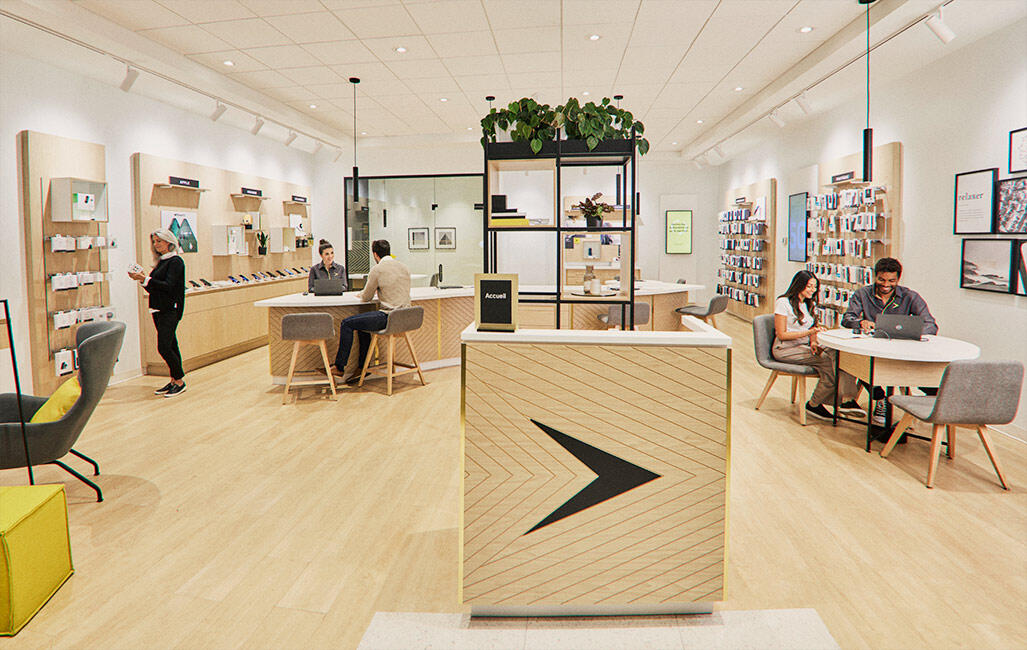
The bar and restaurant industry has been one of the hardest hit during the pandemic. There is a glimmer of hope on the horizon, however. The easing of sanitary measures announced by the government will enable establishments to welcome a greater number of customers. Bar and restaurant owners are nonetheless left to contend with the increasing cost of food and an especially difficult labour shortage. Thankfully, technological solutions exist to help rise to the challenge.
Facts
- 51% of bars and restaurants have experienced losses in revenue of 40% or more in 2020 compared to 2019.[ln]
- 50% of restaurateurs are planning to permanently adopt delivery or contactless pick-up options in the future.1
- 65% of restaurateurs claim significant or even enormous deficiencies when it comes to their digital capabilities.[ln]
Issue 1: The labour shortage
As with many sectors of the economy, bars and restaurants are suffering under Québec’s major labour shortage. Many establishments have even had to reduce their opening hours to compensate for a lack of employees, in addition to increasing wages to keep the employees they currently do have.
A number of technologies allow you to lighten the load on current employees when you have positions that need filling. Some are more futuristic, such as installing tablets that allow customers to submit their meal orders themselves. This concept isn’t restricted to fast-food outlets, like McDonald’s or Tim Hortons. More traditional establishments, like Sushi Hoshi in Saint-Jérôme, also provide tablets to their customers.
Good to know
The idea is also popular amongst restaurants. Even before the pandemic, in 2019, 33% of family restaurants and 28% of American fine dining establishments planned to invest in facilitating ordering and table payments through devices or mobile applications, according to the National Restaurant Association in the U.S.
Videotron Business and Fibrenoire can facilitate installation of the necessary equipment (in particular tablets and a Wi-Fi network), but certain bars and restaurants can also opt for a more streamlined option in which simple QR codes at each table allow interested customers to order by completing an online form and paying through their phone. For restaurants popular with the lunch crowd, this technology can make up for a lack of servers and reduce operational costs, while also shortening the length of visits and thereby increasing an establishment’s profitability.
Bars and restaurants can even take the idea further by acquiring robots. Robots from Québec firm Québec Robotik can, for example, show customers to their table and carry out their food on an integrated serving tray. Certain models also have a “cruise mode” in order to distribute complimentary items, such as glasses of water or hot sauces.
There are a number of innovations that can be integrated into kitchens without changing your customers’ experience. Installing connected sensors can, for example, facilitate refrigerator management and the procurement process. As part of a proof-of-concept for Subway restaurants in the Montréal region, Videotron Business, in partnership with X-Telia, equipped refrigerators and freezers with two sensors that allowed managers to detect whether the equipment had been open for too long, and to measure temperature and humidity levels towards ensuring compliance with cold chain maintenance requirements. All this information is accessible from a web or mobile dashboard. And when a freezer or refrigerator has been open for too long, a manager receives an alert on their phone.
This type of system also allows food losses to be reduced, which is even more crucial given increases in the cost of food in recent months. In Canada, the 2021 edition of Canada’s Food Price Report estimates the increase in food costs to be around 5% on average in 2021. However, this increase is not the same across all food types. The cost of a beef roast, for example, increased by 12% between January 2020 and May 2021.
The Internet of Things can also be used for other purposes, such as to automate the ordering of products that bars and restaurants may be about to run out of, thereby allowing employees to handle other, more urgent tasks.
Issue 2: Lack of digital development
Digitizing operations facilitates the deployment of new technological tools, whether in order to reduce costs, increase customer satisfaction or fill a gap in your workforce. But unfortunately, for some companies, the process can be more onerous than for others.
Sixty-five percent of restaurateurs claim significant or even enormous deficiencies when it comes to their digital capabilities, according to Adobe Research. And the situation seems to be even worse for independent restaurants, who have also been more affected by the pandemic than fast-food and big chain establishments, according to the study Perspectives on Retail and Consumer Goods by consulting firm McKinsey.
Good to know
This technological lag is likely to continue for several more years, while fast food chains—backed by large corporations with solid management and continuing investments in technology—should recover their pre-pandemic revenue levels before full-service restaurants, who will likely have to wait until 2024 to see a similar recovery in the case of fine dining establishments, according to McKinsey.
Videotron Business and Fibrenoire can help you accelerate your digital transformation so you can catch up and reduce the gap.Digitizing operations offers many interesting opportunities to players in this sector. Cloud-based communications solutions (including cloud-based VoIP, or “voice over Internet Protocol”) allow you to reach your employees wherever they are, for example, and even offer certain employees the option of working from home, when possible.
This solution also enables owners of restaurant chains to centralize calls. In addition to lightening the workload for employees of these establishments, this functionality allows you to better allocate your customers, who may be redirected to other restaurants when the location they are calling is full, for example.
The digitization of restaurants also makes the installation of tools such as dynamic menu displays possible, thanks to software known as Netsign.TV, developed by Québec company Advisia.
A digital display of this type is particularly well adapted for the realities brought about by the pandemic, in which certain restaurateurs cannot offer a traditional printed menu at all times. Dishes that cannot be sold due to a lack of ingredients, or which take too long to prepare given the number of employees on hand, can be easily removed from a digital menu without giving customers the impression they’re being served a more limited experience.
Restaurateurs can also take advantage of digital menus to allow their customers to submit their orders on-site, whether through a shared tablet or their own phone, using QR codes that redirect to an online form, for example.
In the U.S., 88% of restaurateurs would consider replacing their physical menus with digital ones, according to a study conducted by payment service Square published in early 2021.
Almost every aspect of bar and restaurant service can be digitized. A solution like Alfred, by Celliers Intelligents, can for example automatically track the inventory of a wine cellar and remove items in real time from the menu when necessary. This Québec-made tool can also inform staff of the optimal period in which wines in the cellar should be consumed and adjust prices based on the market value of the bottles in question. This information can then be used in a variety of ways by restauranteurs—they could for example offer a wine by the glass before it starts to decline in quality or even optimize the menu based on wines that have reached full maturity.
There are also platforms that allow you to more easily manage reservations in the dining room, such as RESY and OpenTable. These tools lighten the workload for staff in addition to providing other advantages for restaurateurs, such as access to information on customers’ previous visits, which facilitates better service and increases the quality of their experience. A reservation platform can also automatically send an email to customers on the day of their reservation or provide an easy way to cancel if necessary, which reduces the risk of leaving a table free when a reservation doesn’t show up.
Staff management can also be digitized. Here too, the immense advantages available during normal periods are compounded during a pandemic. For example, it’s possible to develop an SMS hub to simplify communication with employees. A restaurateur who is informed that a cook cannot make their shift the next day can therefore send a message immediately to other staff members, whether through a mobile app or even simply by email. The first to answer can work the extra shift, while the boss has solved their problem simply, without spending a lot of time on the phone.
Issue 3: Fewer customers
The pandemic has had significant effects on restaurateurs in Québec, where 51% of bars and restaurants have experienced losses in revenue of 40% or more in 2020 compared to 2019, according to Statistics Canada.
Despite the relaxation of sanitary measures, Canadians themselves are attending in fewer numbers. According to Statistics Canada, half of Canadians expect to spend less in restaurants than before the pandemic. On the other hand, the cost of rent during this period has continued to increase.
Good to know
The switch to delivery and take-out represents a good opportunity for reaching customers and increasing sales, despite the fact that dining rooms cannot operate at full capacity. Fifty percent of restaurateurs are planning to permanently adopt delivery or contactless pick-up options in the future, according to Statistics Canada (April 2021).
And yet it’s well understood that companies like Uber and Skip are not a panacea, given they have increased their fees, which cuts into restaurants’ profits. However, it’s possible for restaurant owners to offer customers a similar experience to these platforms while still maintaining their former profitability.
For example, we can help you connect your fleet of cars, whether through a mobile application for delivery people or through connected sensors to track cars on the road (which might also be helpful for managing the recharging of electric vehicles). This way, your customers can see when their delivery arrives on their phone, as they do with other third-party applications.
In restaurants, installing robust Wi-Fi will enable you to receive customers’ orders while improving their dining room experience. An LTE redundancy system can also be deployed to ensure you can always be reached, even when the Internet goes down. LTE redundancy adds another layer of reliability to the network. If your network should go down for any reason, LTE redundancy kicks in to ensure service continuity both on-site and for delivery.
You obviously don’t need to reinvent the wheel to offer smart delivery service. Québec platform UEAT, which was recently bought out by payment service provider Moneris, only costs a fraction of the price of the international giants, for example, and offers a turnkey service in which restaurateurs who own their own delivery fleet can realize substantial savings compared to the big international platforms.
Establishments can also change their line of business, at least for part of the day, in order to take advantage of the surge in teleworkers. Thirty-two percent of Canadians between 15 and 69 now spend most of their time working remotely, according to Statistics Canada. Five years ago, only 4% of Canadians could make the same claim.
All these remote workers don’t necessarily have either the space or the equipment they need to properly execute their tasks at home. Offering them a space, with appropriate services (such as robust Wi-Fi that prioritizes bandwidth for customers during certain hours to ensure a high-quality experience, as well as delivery reception, soundproof booths, etc.) can maximize the profitability of an establishment beyond its usual busy period. In the middle of the pandemic, Perko Café in Villeray, Montréal, notably transformed itself into a co-working space by offering a printer for customers’ use and the ability to book its office for the day.
Other establishments could decide to benefit from delivery applications by creating a virtual restaurant. For example, a bar could transform its small kitchen into a restaurant specializing in chicken wings, advertising solely on applications with a distinct name and logo. A more restricted menu can be created targeting cost-effective dishes that are easy to produce and well-adapted to delivery. Restaurants could also put this strategy to use, as did the chain Pizza Pizza, which created virtual restaurants called Poulet Poulet.
Our specialists can help you put together a solution that best responds to your needs, based on your resources. Technological tools can be quickly deployed to increase businesses’ profitability from their very first day of use. Plus, contrary to what you might think, such transformations don’t require any major investments. Our partners’ software tools are generally priced by use or by month, and Videotron Business and Fibrenoire offer solutions for a monthly fee that require no major acquisition expenses. Notably these also include equipment, updates, and technical support. These are definitely options to consider, especially given the difficult period bars and restaurants have been forced to deal with since the start of the pandemic.
These are just a few examples of everything that is possible through digital. The technological solutions available to help bars and restaurants survive the pandemic are numerous, but locating them can be hard. Videotron Business and Fibrenoire specialist services can help you achieve your goals by setting up customized solutions that respond to your needs, in conjunction with our network of reliable, established partners, many of whom are based in Québec. We can also ensure that your infrastructure will be powerful and well-adapted to all these new digital solutions, which will put additional pressure on your network.
7 October 2021, By Videotron Business
Join the community
We’re here to help
References






